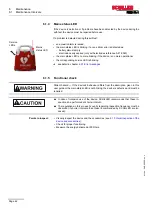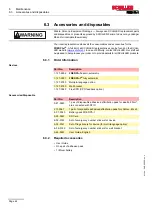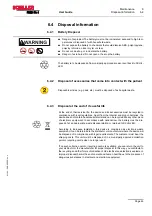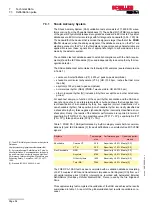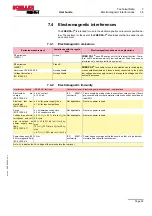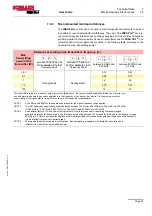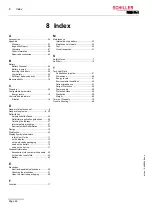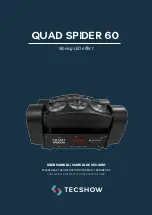
7
Technical Data
7.3
Defibrillation pulse
Page 54
A
rt.
no.
: 0-4
8-02
40 Rev. c
FRED PA-1
7.3.1
Shock Advisory System
The Shock Advisory System (SAS) validation test set consists of 17,803 ECG wave-
forms coming from the PhysioNet databases [1]. These files (MIT-VFDB) are subsets
of the general PhysioNet databases recognised as standard in ECG tests. PhysioNet
databases are ECG Holter recordings with full diagnostic bandwidth [0.05 - 125] Hz.
The bandwidth of the devices that recorded the signals is larger than that of the
FRED
PA-1®
. However, when the analogue signals of the database are run on the PA-1 via
electrode connector, the PA-1's rhythm detector signal-processing characteristics are
applied. Moreover these signals are of appropriate length to allow decisions to be
made by the detector system.
The validation test set database used to establish compliance with the AHA require-
ments [2] and the IEC Standards [3] is used independently to develop the rhythm rec-
ognition detector.
The SAS validation test set contains the following ECG samples (see test sample size
in Table 1):
• coarse ventricular fibrillation (VF) (>200
μ
V peak-to-peak amplitude)
• shockable ventricular tachycardia (VT hi) (HR >150 bpm, rushes that last more
than 8s)
• asystole (
≤
100
μ
V peak-to-peak amplitude)
• normal sinus rhythm (NSR) (PQRS-T waves visible, HR 40-100 bpm)
• other organized rhythm (N) (includes all rhythms except those in other listed cate-
gories)
For each test sample, in function of the expert rhythm annotation and the SAS deci-
sion (shock/no shock), an interpretation table is built and shows the true positive (cor-
rect classification of a shockable rhythm), true negative (correct classification of a
non-shockable rhythm), false positive (non-shockable rhythm incorrectly classified as
a shockable rhythm), false negative (shockable rhythm incorrectly classified as non-
shockable). Finally, the results of the detector performance are reported in terms of:
specificity-Sp (TN/(TN+FP)), true predictive value (TP/(TP + FP)), sensitivity-Se (TP/
(FN + TP)), false positive rate (FP/(FP + TN)).
Table 1: FRED PA-1 SAS performance by rhythm category meets AHA recommen-
dations [2] and IEC Standards [3] for adult defibrillation on artefacts-free MIT-VFDB
signals:
Rhythms
Test sample
size
Performance goal Observed perfor-
mance
[1]: The MIT-BIH Malignant Ventricular Arrhythmia
Database
http://physionet.org/physiobank/database/vfdb/
[2]: Automatic External Defibrillators for Public Ac-
cess Defibrillation : Recommendations for Specify-
ing and Reporting Arrhythmia Analysis Algorithm
Performance, Incorporating New Waveforms and
Enhancing Safety ; Circulation, 1997 ; 95 :1677-
1682.
[3]: Standard IEC 2010 60601-2-4, ed 3.
Shockable
Coarse VF
308
Sensitivity > 90% Meets [2-3]
VT hi
202
Specificity > 75% Meets [2-3]
Non Shockable
NSR
1023
Sensitivity > 99% Meets [2-3]
Asystole
4798
Sensitivity > 95% Meets [2-3]
Other rhythms
1425
Sensitivity > 95% Meets [2-3]
Total NS
7246
Sensitivity > 95% Meets [3]
The FRED PA-1 SAS test has been completed with a validation database consisting
of 2,475 couples of ECGs and transthoracic Impedance Cardiogram (ICG) from out-
of-hospital cardiac arrest (OHCA) interventions, recorded with Automated External
Defibrillators (FredEasy, Schiller Medical SAS, France) used by the fire brigade of
Paris.
This supplementary test completes the validation of the SAS and achieves the results
summarised in table 1. A report of the global validation test results is available on re-
quest.



